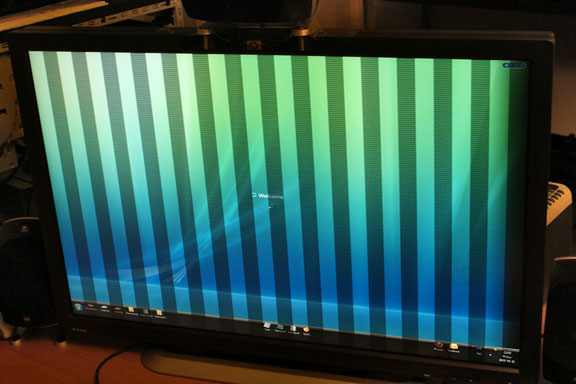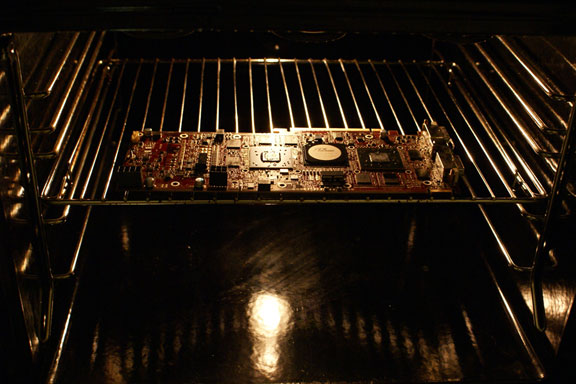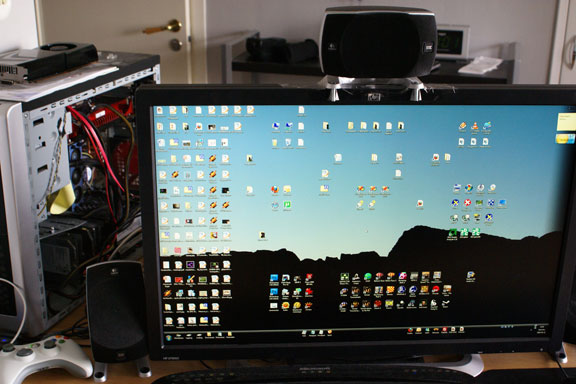More pages: 1 2 3
Baking with Humus
Saturday, August 22, 2009 | Permalink
Today we'll be baking a working GPU.
What you need:
1) One broken GPU
2) A crazy mind
Verify the GPU is still broken.

Remove heatsink and all detachable parts from GPU. Put the GPU on a few supporting screws in the middle of the oven and bake at 200-275C until lightly brown on various plastic parts.

Let it cool gently in the oven. Reattach heatsink and other parts. Put into computer and boot it up. Verify that the card is now functional.

Whooha, you actually did that? Yep.

So what's the deal? Well, I read
a forum post where someone had resurrected a video card by putting it into the oven. Some people also claim to have resurrected their Xbox360 by putting it into a few towels and let it run for about 20 minutes. The reason why this sometimes works is that a leading reason for hardware failure is solder joints that crack over time. If you heat the device enough it will cause the solder joints to melt and reconnect. The melting point of commonly used solders are within reach for a regular household oven.
Some of you may recall I had
a broken 3870 X2. So I thought I should attempt this trick on it. Just to give me a sense of how well this would work I first attempted this on an old SiS AGP card I found in my closet. I didn't even know I owned one, heh. So I put it into the oven and turned it to 200C. It didn't even reach that temperature before I heard something fall. Turned out some component fell off.

Lesson learned was to not put the card upside down. Seems kinda obvious afterwards, but with melted solder it will of course fall off if it's hanging under the card with only the solder joint supporting it. Then I tried it on the 3870 X2. I had to heat it much further before the solders melted. I opened the oven and poked a solder joint now and then to see if it was still hard. I had to go all the way to 275C before it finally melted. I turned off the oven and let it cool gently in there for a couple of hours before taking it out. Then I looked very carefully at all the solder joints to verify that nothing had melted too much and made a short circuit. This is of course a very important step if you're attempting this trick. A short circuit could potentially damage your whole computer or cause a fire, so don't try this if you're unwilling to take any chances. Keep an eye on the card during the whole process and double check the results. If you see any signs of any solders having flowed away from its attachment point, you may consider not attempting to boot it up. Everything looked fine on my card though, but I did at least make a full backup of my important files to an external drive before putting it into the computer. Booting up the card it now appears to work. I've been gaming on it for a couple of hours with no problems so far.

voidmain
Wednesday, September 2, 2009
I tried retrieving my data using several tools, but all my attempts have failed. I took the disk apart, and it seems that the disks were fried from the inside. I guess it has nothing to do with my attempt to bake the graphics card. It's just that bad things tend to happen to you at the exact same time...maybe karma. Anyway, about the graphics card...I think I should sue you

The only reason I'm not doing so is that I think the graphics card's new brown color looks better as the original green.

gregor
Friday, September 11, 2009
A friend of mine got a broken GPU and we thought
about baking it, but we were to scared to kill his system by that. With the broken card and a working card still in his PC, we go and got dinner. A little later we returned ... and it smelled baaaad.
The GPU fan was blocked and the card got hot, really hot, untouchable hot.
After cooling it down and installing it again (without blocking the fan) ... IT WORKED!!!
So not only baking it in the oven, but also
ISB (= In System Baking) by blocking the fan
could repair joints!
Humus
Friday, September 11, 2009
ROFL, that's even more nuts.

ANgel g.
Tuesday, November 3, 2009
Need to clarify - do this only if you`re ready to kill the card or probably mainboard without regret.
Modern video cards can have electrolytic capacitors which can hardly withstand 105C without leakage/explosion. If they are on a PWM voltage regulator, the GPU juice won`t be filtered anymore. Then *BAD* things can happen. Fore example peaks may cause semiconductor to melt and do a short-circuit. Then PSU may fail, buses may get short-circuited or thin PCB tracks can burn.
macnihilist
Saturday, February 6, 2010
WOOT!
I just resurrected my 8800GTX in the oven.
GPU-Z readings look ok and I played Dragon Age and Cod4 for about an hour now.
Thank for the hint, I never would have thought about that.

cosmofen
Wednesday, April 14, 2010
счас тоже начну нечто такое,но тольуо помещю не в духовку,а на саму плиту
GianT
Tuesday, July 20, 2010
Hi Humus,
A friend of mine saw this post of yours and thus decided to try resurrecting one of my old cards, and he did so successfully.
Before the operation, the card would make his PC crash shortly after booting into the OS. But after the operation, he was able to run FurMark for 2 hours without a problem.
Good recipe, chef :-)
Mickey
Monday, January 20, 2014
I have a Dell XPS M1730 17", and one day out of the blue, my screen went black everything turns ON but my screen doesn't, what can I do...?
More pages: 1 2 3






